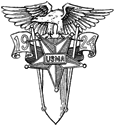
Leslie Earl Simon was born in Memphis, Tennessee, 11 August 1900. He was graduated from the Hume Fogg High School, Nashville in 1919 and was appointed a cadet at the US Military Academy in 1920. He was graduated from West Point in 1924 and commissioned a second lieutenant in the Coast Artillery Corps.
Leslie’s first assignment was at Fort Winfield Scott, California. In January 1925 he joined the 91st Coast Artillery at Fort Mills, Philippine Islands. Returning to the US in February 1927, he was detailed to the Ordnance Department. The following August he entered the Massachusetts Institute of Technology from which he received his Bachelor of Science degree in mechanical engineering in June 1929, and was assigned to Fort Sill, Oklahoma. On 11 December 1930, he was transferred to the Ordnance Department and three years later was assigned to Picatinny Arsenal, Dover, New Jersey.
In 1933, Leslie was assigned to work in the manufacture of munitions at Picatinny Arsenal. Here, as a young officer, he studied under the renowned Doctor Walter A. Shewhart who guided him in inaugurating statistical quality control and the grand lot sampling techniques which proved of great value in the manufacture, sampling and testing of munitions, as well as the reliability of component parts of other products of the manufacturing industry. This was the first application of an engineering science that has now given rise to one of the country’s large national engineering societies, the American Society for Quality Control. Leslie’s book on the subject, An Engineers’ Manual of Statistical Methods, is still a leading textbook in this field. For his original and creative work in modern quality control, Leslie was awarded the Shewhart Medal of the American Society for Quality Control in 1947.
In July 1937, Leslie was transferred to the Ballistic Research Laboratory at Aberdeen Proving Ground, Maryland, where he spent a year as an industrial research worker on the application of statistical methods to the detection of deterioration of ammunition in storage, and the scientific inspection and grading of ammunition lots. This work led to the creation of the Army Surveillance System through which the Army Surveillance Laboratory keeps a reliable and watchful eye on the country’s war reserves of ammunition. These methods developed by Leslie are now applied to the reserves of ammunition of the Army, Navy, and Air Force.
In July 1940, Leslie was appointed assistant director of the then infant Ballistic Research Laboratory, and became director in 1941. Under his directorship, the institution grew to a world-renowned group of laboratories and one of the leading scientific institutions not only of the Army but also of the country. Some of the outstanding achievements of these laboratories, under his direction, were the country's first supersonic wind tunnels; the world's first long-range tracking telescopes for tracking guided missiles; and the creation of the ENIAC, the first high speed digital computer, which led to the so-called “electronic brains" and the present-day electronic computing and accounting industry.
During his service as director of the Ballistic Research Laboratories (1941-49), Leslie had two periods of wartime temporary duty in Europe during the summers of 1944 and 1945. The first was as leader of a team whose mission was to scientifically sample, sort and arrange into the most useful lots ammunition for the Normandy Invasion. For the successful achievement of this work, he was awarded the Legion of Merit. The second mission to Europe was to study and make available for this country the methods, organizational planning and products of research developed before and during the war in Germany. His popular version of this work, German Research in World War II, is used as a textbook in college courses on the management of research.
In December 1949, Leslie, then a colonel, was appointed chief of the Research and Development Division of the Office of the Chief of Ordnance in Washington, DC and in 1951, then a major general, became assistant chief of Ordnance with all his former duties. His major work was that of organizing all Army weapons research and development on a unified and consistent basis from basic research to engineering for production. Some of the major developments during his administration were radically new and powerful anti-tank weapons such as the BAT and ONTOS; the NIKE anti-aircraft guided missile; the CORPORAL surface-to-surface guided missile; and the HONEST JOHN long-range, artillery rocket.
Although Leslie was retired for physical disability on 30 November 1955, he served as staff director of research from 1956-1960 for the Carborundum Company, Niagara Falls, New York. He also served on numerous corporation boards, and as a fellow in many technical societies and organizations. He has written three books and presented or published many papers.
Leslie was awarded the Distinguished Service Medal for Military Research and Development, the Legion of Merit, an Honorary Professorship of Applied and Mathematical Statistics (Rutgers University), and the Samuel S. Wilks Memorial Award of the American Statistical Association. He holds the US Army Simon Award, “named for Major General Leslie Earl Simon, and struck in his likeness,” to be given annually in recognition of scientific achievement. In 1985 the Leslie E. Simon Building, housing the Ballistic Research Laboratory at Aberdeen Proving Ground, was dedicated. He is included in the US Army Ordnance Hall of Fame.
It can truly be said that Leslie Simon left his prominent mark on the modem scientific world. He was among those outstanding in his profession who contributed their extraordinary talents, not only to the research and testing of military weaponry, but also to the development of electronic computing and accounting systems upon which so much of modern day industry depends.
He is survived by his wife Marie and two children, Carolyn (Simon) Hubbs and Leslie Andrew Simon.
“His Friends”
